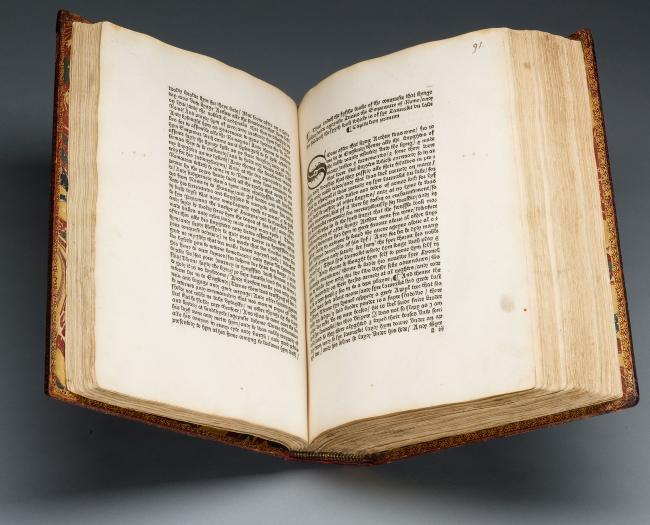
Author, title, and imprint from colophon (leaf ee6r): Thus endeth thys noble and joyous book entytled le morte Darthur/ Notwuthstondyng it treateth of the byrth/ lyf/ and actes of the sayd kyng Arthur/ of his noble knyghtes of the rounde table/ theyr mervayllous enquestes and adventures/ thachyevyng of the sangreal/ [et] in thende the dolorous deth [et] departyng out of thys wolde of them al/ which book was reduced in to englysshe by syr Thomas Malory knyght as afore is sayd/ and by me devuded in to xxi bookes chapytred and enprynted / and fynysshed in thabbey westmestre the last day of Juyl the yere of our lord /M/CCCC/lxxxv/. Caxton me fieri fecit.
Printed in Caxton's type 4:95B.
Collation: [1]⁸ [2]¹⁰; a-z, [et], A-Z, aa-dd⁸ ee⁶: 432 leaves, leaf [1]/1 blank. First quire with leaves 2, 3, and 4 so signed; second quire with leaves 1, 2, 3, and 4 signed as 5, 6, 7, and 8.
Paper format: Chancery folio
Only other known copy at the John Rylands Library, University of Manchester, missing 10 leaves replaced in facsimile.
For an account of the paper stocks in this edition, see BMC XI 321 and the Scolar Press facsimile of this copy, pp. 10-32.
PML copy leaf dimensions: 28.6 x 20.8 cm.
PML copy missing 1 leaf: [1]/1 (blank).
PML copy reproduced in facsimile: Scolar Press, 1976, with an introduction by Paul Needham.
Le morte Darthur
Hand decoration: Rubrication not required. Annotations: 1 marginal notation in text: "honor," in crayon, 16/17th century (leaf T5r). Black ink smudges/fingerprints sporadically throughout. Modern foliation up to 130.
Watermark: page 6. Hand with sleeve cuff.
Watermark: page 9. Shield with diagonal straps inside.
Watermark: page 15. Shield with diagonal straps inside.
Watermark: page 10. Dog with collar.
Watermark: page 70. Scissor centered on chain line.
Watermark: page 77. Hand with five-pointed star.

William Caxton (ca. 1422-1491/92) was a merchant, diplomat, translator, author, and publisher. With an eye toward commercial opportunity, he learned the new technology of typographical printing while in Cologne, Germany and focused on the untapped market of English texts for English readers, becoming the first printer in London (Westminster) by about 1476. Caxton published more than one hundred titles ranging from works of English literature to religious and historical texts. He helped to stabilize the English language by choosing to print in only one of the multiple dialects in use at the time; through print this dialect became more widespread and helped to form the basis of modern English. The Morgan has one of the largest collections of Caxton imprints in the world, collected for their literary, linguistic, and historical importance. J. Pierpont Morgan favored Caxton over Johann Gutenberg as a founder of printing and chose to memorialize him in the ceiling of the East Room.
One of Caxton's most ambitious publications was Sir Thomas Malory's great epic of Arthur and the Knights of the Round Table. Malory based his text almost solely upon the older French Lancelot-Grail cycle, which he translated while in Newgate Prison between 1460 and 1470. Despite its size (this edition is over 860 pages), some consider Le morte d'Arthur to be the first English novel. It is perhaps the most significant work of English literature between Geoffrey Chaucer and William Shakespeare, and it forms the basis of all modern Arthurian legends and stories. Caxton's printed edition bears no decoration, with even the initials beginning each chapter printed in black, which suggests that it was not intended for an elite audience who would pay extra for painted initials. This was a more affordable book for a more general audience. Only two copies of this edition survive (the Morgan's copy being the only complete copy), and its rarity suggests that copies were read until they fell apart and had to be replaced.